Top Types of Pallet Racking Systems For Warehousing
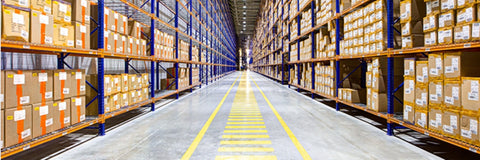
The right pallet racking system can improve your operations by streamlining your workflow and enhancing your productivity.
There are many different types of pallet racking systems to choose from in your warehouse. In this guide, we will explore these different types and the advantages and disadvantages of choosing them.
What is a Pallet Racking System?
A pallet racking system is a storage solution that allows you to take advantage of vertical space to store your products. These items are typically stored in horizontal rows on multiple levels. Products are stored onto pallets which are then moved into place by utilizing a forklift and other types of material handling equipment which depend on the type of the racking system that is being used.
In order in increase your warehouse’s efficiency, you can consider the storage and retrieval method that is being used in addition to the stock rotation. The stock rotation has two main methods which are First-In-First-Out (FIFO) and Last-In-First-Out (LIFO).
In FIFO storage, you can access the pallets without having to remove other items. FIFO is typically used for time-sensitive items with an expiry date such as food items or pharmaceuticals. and items with a high turnover rate. LIFO storage on the other hand allows you to remove the most recently stored pallet in the rack. LIFO is typically used for homogenous products that do not expire or lose value over time such as construction material.
A pallet racking system also reduces damage to merchandise since products are typically wrapped in cartons and stored in pallets. The racking system improves the material handling which reduces waste and potential damage to merchandise.
A pallet racking system is a long-term investment and can last for decades with proper maintenance. Because you don’t need to constantly replace your rack, a pallet racking system offers a great return on investment. Proper material handling can also reduce your operational costs as less labor is required to handle the materials.
Types of Racking Systems
- Conventional Pallet Racking
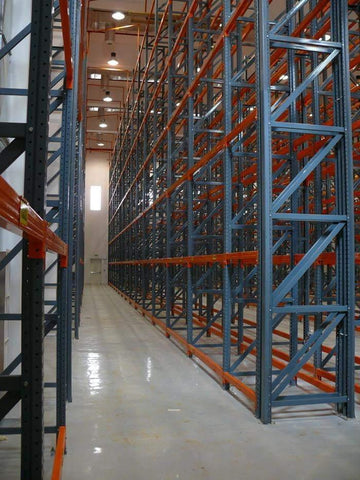
The conventional pallet racking which is also known as the “selective” pallet racking is the most popular configuration among warehouses. Its popularity is due to its versatility in keeping a wide range of merchandise on different types of pallets. It allows for 100% access to each load and can store items at various heights. A wire mesh can also be utilized to protect items from falling or damage.
Advantages of Conventional Pallet Racking
- 100% access to all pallets
- Can be configured in various ways depending on your requirements
- Easy to install and dismantle
- Modular structure with the ability to expand vertically and horizontally for future needs
Disadvantages of Conventional Pallet Racking
- Lower storage density compared to other types of racking
- Less efficient use of space since aisle space is not fully optimized
- Narrow-Aisle Pallet Racking
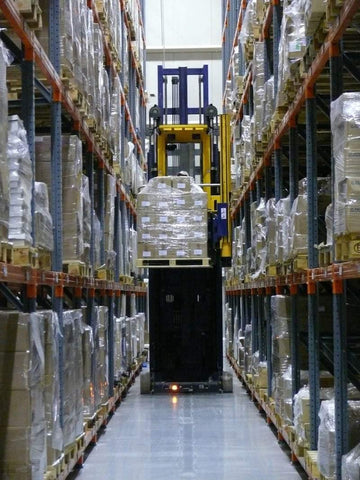
The narrow-aisle pallet racking has the same configuration as the conventional pallet racking although it utilizes special equipment to handle pallets in narrow aisles. It makes optimum use if the floor area and elevation while allowing for access to all pallets. It is commonly used when land cost is high or running expenses are high such as in controlled warehouse environments (e.g. temperature, humidity, etc.). This type of racking requires special training in order to operate the equipment safely and minimize material handling damage.
Advantages of Narrow-Aisle Pallet Racking
- Makes optimum use of floor space and elevation. Up to 50% more inventory storage in the same space.
- Allows for 100% access to all pallets
- Works well for uniform products with similar sizes and shapes
Disadvantages of Narrow-Aisle Racking
- Requires special material handling equipment and training due to narrow aisles
- Potential for increased damages to racks and pallets during handling and storage
- Not suitable for irregular shaped or oversized products
- Drive-In Pallet Racking
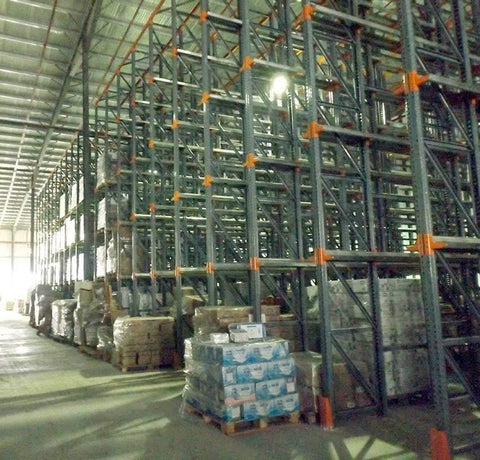
Drive-in pallet racking allows a forklift truck to enter the rack from one side to pick up or pull out the pallets. Forklifts drive into the rack two or more deep. The depth of storage for a particular bay is limited by the size of the facility.
Drive-in racks offer the ability to store a large amount of similar loads in a smaller area. Selectivity is sacrificed but the storage density is outstanding. Drive in racking can store up to 75% more pallets for the same space of selective conventional racking.
Drive-in racks can be single entry where the lift truck can only pick up pallets from one side. This allows only for Last-In-First-Out (LIFO) operation. In a double entry drive-in rack (which is also called Drive Through Racking), lift trucks can pick up the pallets from two sides which allows for First-In-First-Out (FIFO) operation. However double entry drive-in rack requires more space than single-entry drive-in racks.
Advantages of Drive-In Racking
- Allows for higher density storage if space is limited (e.g. cold rooms or freezers)
- Can store up to 75% more pallets for the same space as selective conventional racking
- Works for low turnover similar Stock Keeping Unit (SKUs)
Disadvantages of Drive-In Racking
- Access to pallets is reduced due to the nature of storing the pallets in drive-in racking
- Forklift damage is potentially higher because of the tight spacing available
- Drive-in racks are susceptible to honeycombing which is when the operator fails to deposit the load at the back of the racking system thus creating un-utilized storage space.
- Pallet Shuttle Racking

The pallet shuttle is a high-density compact storage solution that utilizes an automated powered shuttle to carry loads into the rack. The pallet shuttle is remotely controlled by the operator. This allows for maximize use of storage space in addition to reducing product damage and workplace accident rates. The use of the powered shuttle in place of forklifts also reduces maintenance costs as damage to the racks are reduced.
The pallet shuttle moves in designated rails that lift the pallets into desired empty locations. At the end of the task, the pallet shuttle returns to the front of the lane to be ready for the next task. The pallet shuttle can be moved from lane to lane using a forklift.
The pallets shuttle can work as First-In-First-Out (FIFO) or Last-In-First-Out (FIFO) operation. It is ideal for high-turnover storage.
Advantages of Pallet Shuttle Racking
- Full selectivity of different Stock Keeping Units (SKUs) at any opening
- Maximize use of storage space
- Reduction of damage to products and racks
- Can work with both First-In-First-Out (FIFO) and Last-In-First-Out (LIFO) operation
Disadvantages of Pallet Shuttle Racking
- Storage of goods is singular and they cannot be accessed randomly
- Pallet shuttle runs on batteries which need to be recharged after operation and replaced after expiry
- Double Deep Pallet Racking
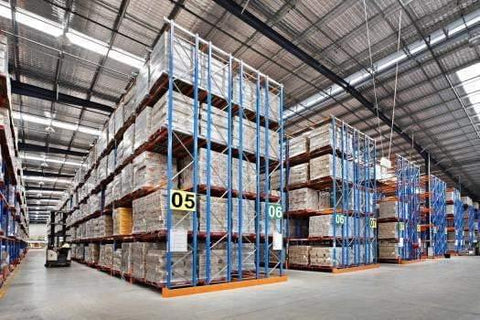
A variant of the conventional pallet racking, double deep pallet racking allows pallets to be stored two deep but still accessible from the same side. By reducing the number of access aisles and using the space saved to accommodate additional racking, double-deep pallet racking provides a highly space efficient storage solution. Although the speed of access to all of the pallet positions is restricted, with an efficient stock management system this can be easily compensated for by taking full advantage of the increased storage density.
Double deep racking provides for 50% immediate pallet access on a Last-In-First-Out (LIFO) basis and makes use of all available locations. This storage solution is best used when each Stock Keeping Unit (SKU) has several pallets.
The double deep racking requires the use of a special reach truck with either dual pantograph or slide fork attachments. Upper levels can be fitted with guide rails to assist the forklift drivers in locating the pallets. They also help in reducing forklift operator error and accidental impact damage.
Advantages of Double Deep Racking
- Higher storage density than conventional pallet racking
- Can be configured in various ways based on your requirements
- Easy to install and dismantle
Disadvantages of Double Deep Racking
- Reduction in selectivity access to the pallets
- Requires special reach truck to access the pallets
- Requires more expensive loading and unloading equipment
- Cantilever Pallet Racking
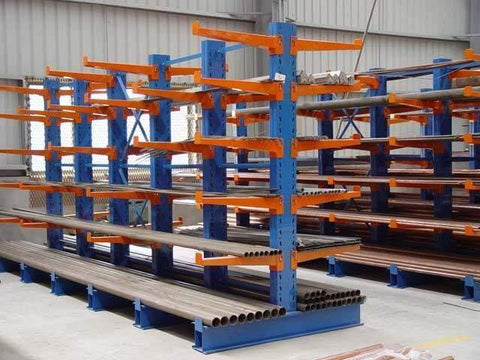
Cantilever racking utilizes arms attached to upright posts which is ideally suited for storing long, irregular and mixed loads whilst giving easy accessibility and excellent product presentation. Cantilever racking is suited for storing products such as timber, furniture, lintels, bars, pipes, sheet, steel, tubing, plastics, windows and insulation.
Advantages of Cantilever Pallet Racking
- Ideal for long loads
- Easy to install and configure based on your requirements
- A broad number of capacity ranges
Disadvantages of Cantilever Pallet Racking
- Can require additional flooring or reinforcement
- Requires a wide aisle for material handling equipment access
- Cannot store pallets
- Drum Racking
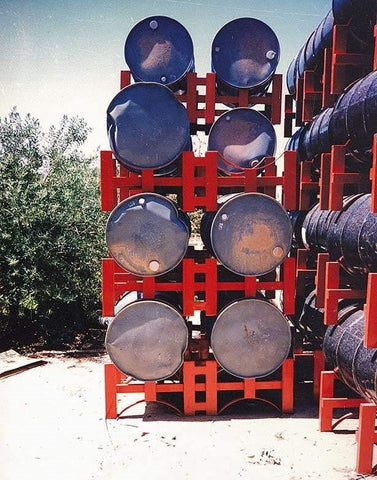
Drum racking is used for safe handling of drum storage for items such as oils, paints, inks and detergents. It can be designed to handle different load requirements whether empty or full drums or cylinders. A forklift can move the drum racks from the front or the back.
Advantages of Drum Racking
- Can be stacked in different levels to maximize storage efficiency
- A forklift can easily access the drum racks from the front or the back
Disadvantages of Drum Racking
- Works only for products that are stored in drums (e.g. oils)
To submit a contact form or request a quotation, please visit the contact us form page by clicking on the below button:
